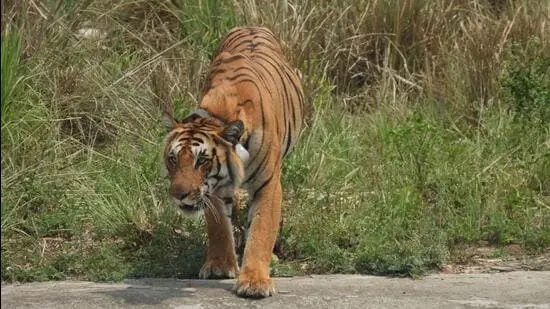
Haldwani: With the tiger population in Corbett Tiger Reserve (CTR) touching 260, the Uttarakhand forest department is planning to relocate five tigers to Rajaji National Park. The move aims to ease growing territorial conflicts within CTR, where shrinking ranges have increased aggressive encounters among tigers, officials said.
A formal proposal has been sent to the National Tiger Conservation Authority (NTCA) and the Head of Forest Force (HoFF) for approval. The translocation will begin once the requisite permissions are granted, officials said.
CTR director Saket Badola said preparations are underway for the second phase of the tiger relocation project. “We have sought permission from NTCA and higher authorities. After approval, specific tigers will be identified and shifted to Rajaji National Park. Forest teams will monitor the movement, health, and adaptation of the relocated tigers through camera traps and tracking devices,” he said.
He said this is the second major translocation effort between the two reserves. “Earlier, three tigresses and two tigers had been moved from Corbett to Rajaji as part of a long-term plan to revive the tiger population in the Rajaji park. The initiative has shown encouraging results. All the relocated individuals adapted successfully to their new habitat,” he said
“Two of the tigresses relocated earlier have already given birth, indicating stable settlement and availability of prey. One tigress delivered three cubs, while the other gave birth to one. They are frequently seen roaming Rajaji with their cubs. This is a positive indicator for the park’s tiger revival programme,” he said.
According to the 2022 tiger census, CTR currently hosts 260 tigers- one of the highest densities in the country. Wildlife experts say the rising numbers have compressed individual territories, triggering territorial disputes. There are 260 tigers inside CTR and 229 outside Corbett. There are more tigers outside Corbett than some of the major tiger reserves in the country like Bandhavgarh (135) and Kanha (105). According to the tiger census report, CTR has “one of the highest density tiger populations in the world, which is a source of tigers in the larger landscape. This has led to negative interaction of tigers with humans in and around the tiger reserve. To gain insights in how a territorial large mammal operates at such high density and provide an early warning system to alert nearby villages of tiger movement, radio collaring of tigers should be carried out in the tiger reserve”.
Wildlife expert AG Ansari said, “A tiger typically requires around 20 sq km of territory. In Corbett, the effective territory available has shrunk to just about 5 sq km due to the high tiger population density. Such overlap increases conflict, injuries, and stress among tigers. Relocation is, therefore, a scientifically justified step.”
Forest officials said relocating five tigers will reduce pressure on CTR while strengthening Rajaji’s tiger population and genetic diversity.
Uttarakhand has the third highest tiger population in the country with 560 tigers, with Corbett Tiger Reserve reporting the highest tiger population with 260 tigers among the country’s 53 tiger reserves, according to the last tiger census. According to the tiger census report, there are 260 tigers inside CTR and 229 outside Corbett Tiger Reserve. In contrast, there are 51 tigers in Rajaji Tiger Reserve.
Centre had approved the Uttarakhand tiger relocation project in 2016 and later a team of the National Tiger Conservation Authority (NTCA) visited CTR and RTR and gave the nod to the project, said officials. The first tiger was translocated in December 2020 followed by a tigress in January 2021. The third tigress was shifted to RTR in May, 2023, and the fourth tigress in March last year . The fifth tiger, a five-year-old male tiger, was translocated in May this year.
Rajaji Tiger Reserve is spread over three districts including Haridwar, Dehradun and Pauri Garhwal. It was formally granted the status of a tiger reserve in April 2015 and has an area of 1,150 sq km approximately. In last year’s Tiger census, the presence of 51 tigers was reported in the eastern part of RTR with tiger density estimated at 8.15 tiger per 100 sq km and in the western part of the tiger reserve, three tigers, which were re-introduced, were photo-captured in the census.
